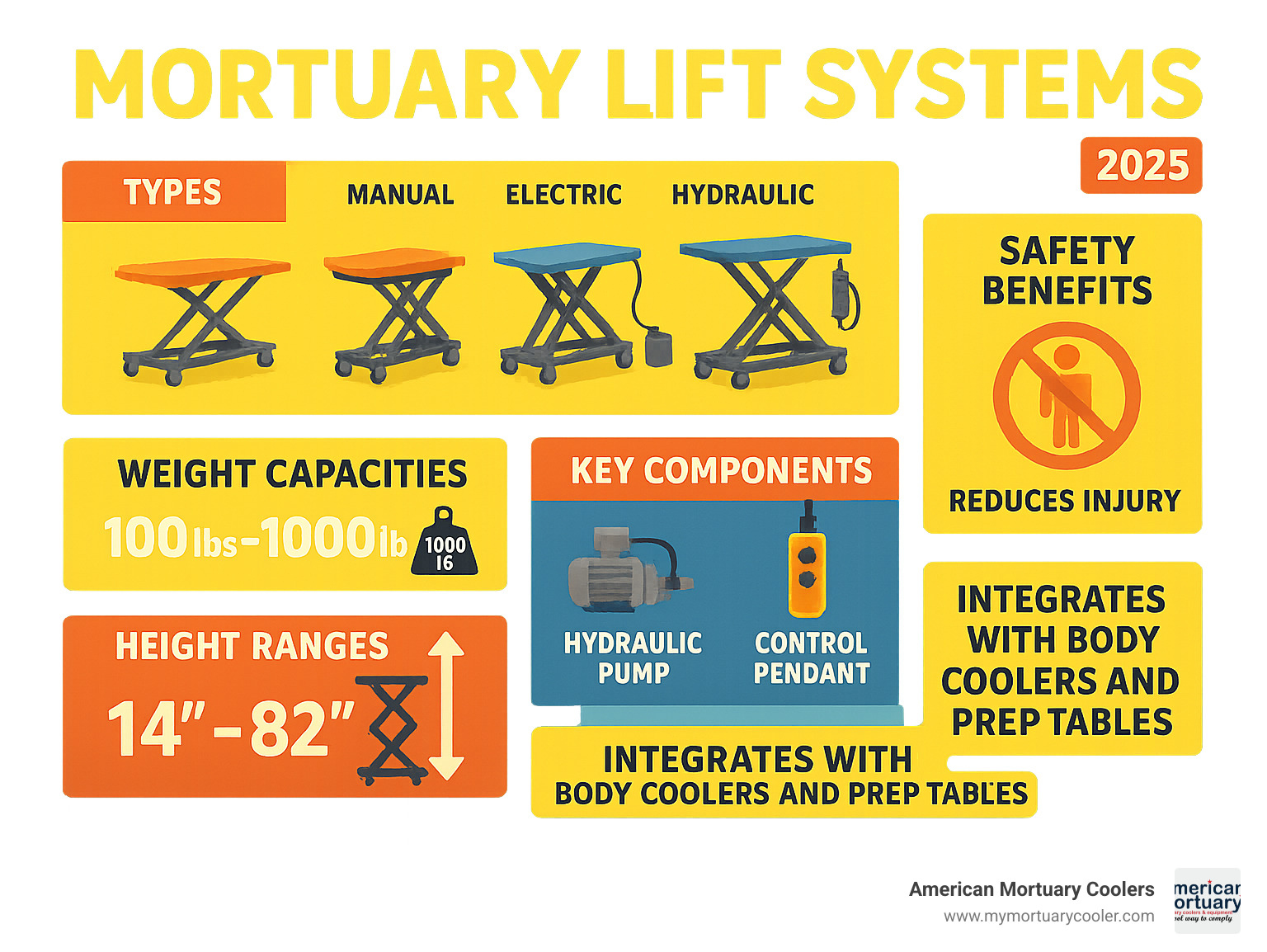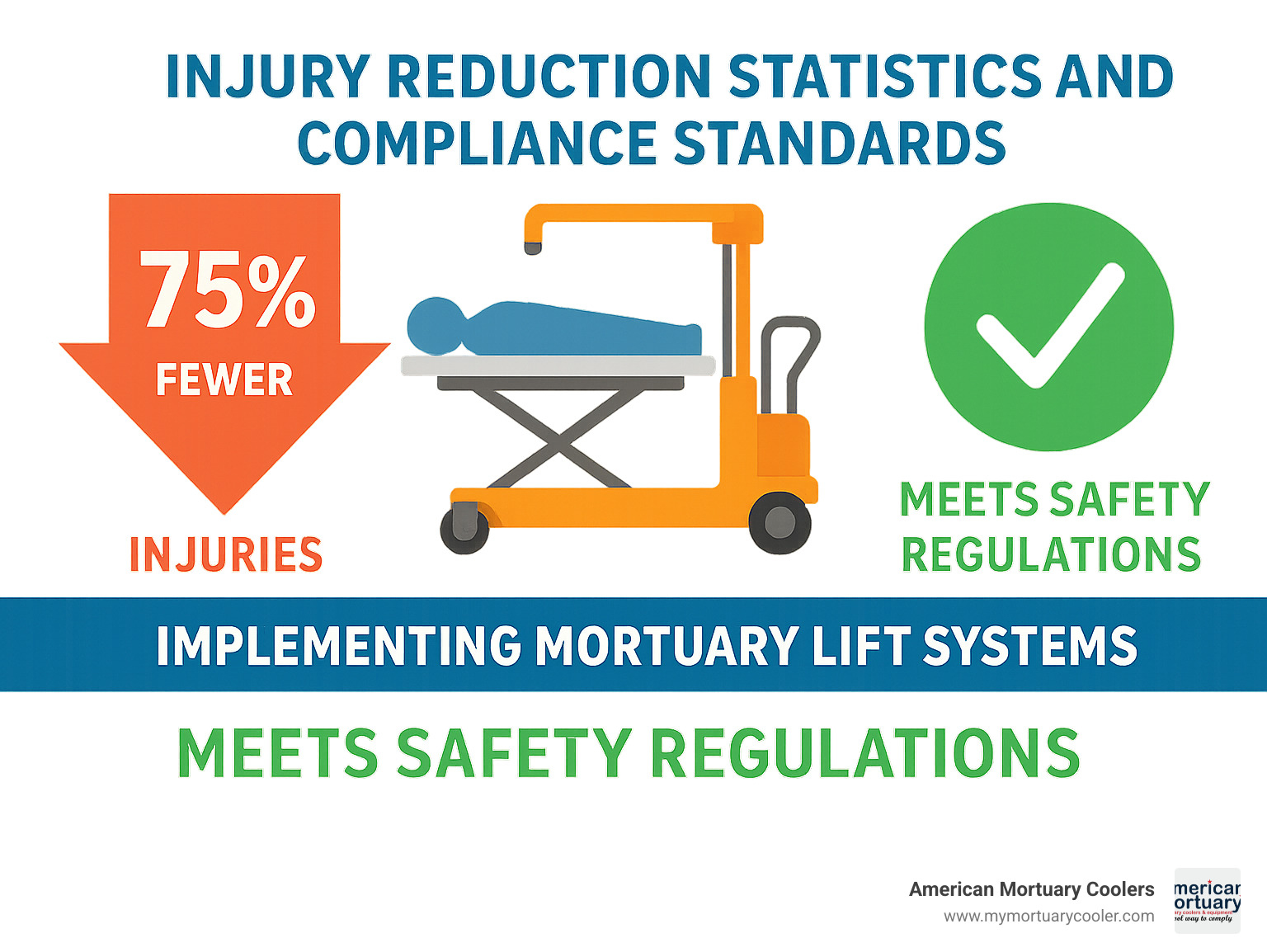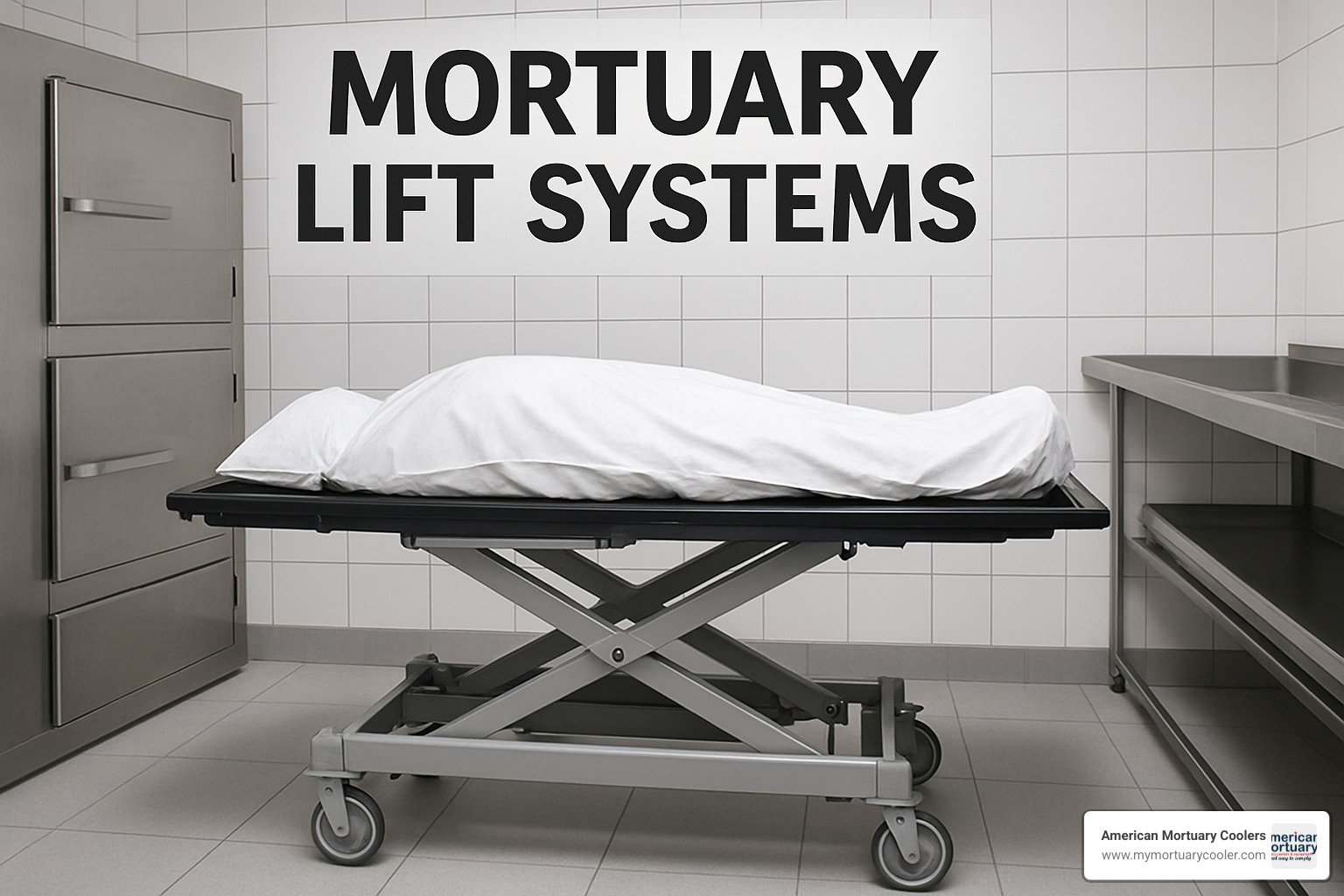
The Complete Guide to Choosing the Best Mortuary Lift System
Why Mortuary Lift Systems Are Essential for Modern Funeral Operations
Mortuary lift systems are specialized mechanical devices designed to safely transfer, position, and transport human remains in funeral homes, hospitals, and morgues. These systems eliminate the need for manual lifting of bodies weighing 200-1,000 pounds, reducing staff injuries while maintaining dignity during transfers.
Quick Overview of Mortuary Lift Systems:
- Primary Function: Safe transfer of human remains between surfaces (tables, coolers, vehicles)
- Weight Capacity: 100-1,000 lbs depending on system type
- Main Types: Manual hand-crank, electric/battery, hydraulic scissor, bariatric specialty
- Key Benefits: Single-operator capability, injury prevention, workflow efficiency
- Height Range: 14-82 inches for most transfer needs
- Cost Range: $300-$8,000+ depending on features and capacity
The funeral industry faces a growing challenge with musculoskeletal injuries from manual lifting. Modern mortuary lift systems allow a single operator to safely handle loads up to 660 pounds, freeing staff for higher-value tasks like family consultation. Over 10,000 Florlift mortuary lifts have been serving funeral homes since 1954, proving their essential role in daily operations.
These systems integrate seamlessly with body coolers, preparation tables, and removal vehicles to create efficient workflows. Whether you're handling everyday cases or bariatric situations up to 1,000 pounds, the right lift system protects your staff while ensuring respectful treatment of remains.
I'm Mortuary Cooler from American Mortuary Coolers, and I've helped hundreds of funeral directors select the right mortuary lift systems to improve their operations while reducing workers' compensation claims.

Basic mortuary lift systems vocab:
Why You Need This Guide
The funeral industry faces significant challenges with workplace injuries, particularly musculoskeletal disorders from manual body handling. Manual lifting of 200-1,000 pound loads causes serious injuries among funeral service staff, leading to increased workers' compensation claims and staffing shortages.
Single-operator capability isn't just about efficiency—it's about sustainability. When one trained professional can safely handle transfers that previously required multiple staff members, funeral homes can allocate resources more effectively while reducing injury risk.
Mortuary Lift Systems 101: Functions & Key Components

Think of a mortuary lift system as the backbone of safe funeral operations. Just like you wouldn't try to move a piano without proper equipment, handling human remains requires specialized tools that protect both your staff and maintain dignity throughout the process.
What Is a Mortuary Lift System?
A mortuary lift system is essentially a specialized crane designed specifically for funeral homes, hospitals, and morgues. Unlike general-purpose lifting equipment, these systems are engineered with the unique needs of body handling in mind.
Every quality mortuary lift performs three essential functions: The transfer operation moves bodies smoothly between different surfaces like prep tables, body coolers, and gurneys. The lifting function raises and lowers remains to precise heights for examination or equipment matching. The load and unload operation handles moving bodies into vehicles, storage units, or crematory equipment.
OSHA guidelines emphasize mechanical lifting aids for loads over 50 pounds. When you're dealing with 200-1,000 pound loads regularly, a mortuary lift system isn't a luxury—it's essential safety equipment.
Core Components Explained
The frame and base form the foundation using heavy-duty steel or aluminum construction. Your forks and platform are where the actual work happens, supporting the body during transfers. Casters and mobility components use quality swivel casters with reliable mechanical brakes for smooth movement and stability.
Floor locks prevent unwanted movement during transfers, while control systems range from hand-crank mechanisms to sophisticated electric controls with emergency stops. The hydraulic pump provides smooth, controlled lifting with precise positioning. Electric actuators deliver quiet operation, and battery packs eliminate trip hazards.
Every system includes emergency stop features and slings and straps using materials similar to vehicle seat belts for proven durability.
For detailed specifications, check out this downloadable cadaver lift manual.
Mortuary Lift Systems: Types, Capacities & Use-Case Fit

Choosing the right mortuary lift systems is like picking the perfect tool for the job. The capacity range spans from basic 100-pound manual lifts up to heavy-duty 1,000-pound bariatric systems. Height ranges typically run from 14 to 82 inches.
Manual & Hand-Crank Lifts
Manual lifts are the reliable workhorses of mortuary lift systems. They handle 100 to 500 pounds using hand-crank mechanisms with idler roller systems that prevent cable damage.
Low upfront costs make these systems attractive at $300 to $1,500. No power needed means no electrical worries or battery charging. These systems shine in low-volume facilities or as backup units.
Electric & Battery-Powered Lifts
Electric systems transform lifting from a workout into precision operation. With capacities from 300 to 660 pounds, these systems let one operator handle what used to require multiple people.
Quiet operation maintains respectful atmosphere, while battery power eliminates trip hazards. Safety features like emergency stops and overload protection provide peace of mind. These systems pay off in high-volume operations.
Hydraulic & Scissor Lifts
Hydraulic systems represent the premium tier for facilities handling 500 to 1,000 pounds regularly. The scissor-lift design provides exceptional stability, while hydraulic pumps deliver precise positioning throughout the full height range.
High-volume funeral homes and hospital morgues find these systems indispensable for intensive daily use.
Specialty Bariatric & Stair-Climbing Solutions
Bariatric systems handle 1,000-pound capacity with reinforced frames and wider platforms. Stair-climbing systems like the Stepper™ handle 375 pounds with single-operator capability for tight spaces.
For more details on optimizing efficiency, check out our guide on climbing efficiency.
Ceiling, Track & Vehicle Hoists
Space-saving solutions preserve valuable floor space while offering extensive reach and 1,000-pound capacity. Track systems customize with lengths up to 23 feet.
Vehicle integration like the Easy Bearer II Lifting System enables single-operator handling of multiple cases. The wireless Tug-Along winch system supports 1,000 pounds with steam-cleaning capability for thorough sanitation.
Safety, Efficiency & Compliance Benefits

The real value of mortuary lift systems goes beyond making your job easier. These systems tackle serious safety issues while boosting operations and maintaining compliance.
When dealing with bodies weighing 200-1,000 pounds, manual lifting isn't just difficult—it's dangerous. Funeral service workers face significantly higher rates of musculoskeletal injuries. Every manual lift risks staff health and business stability through workers' compensation claims.
Modern mortuary lift systems enable single-operator handling of cases that previously required multiple people, freeing up your team for family consultation and preparation work.
Protecting Staff & Preserving Dignity
Ergonomic advantages extend beyond injury prevention. Controlled lowering prevents sudden movements causing back strain, while precise positioning eliminates awkward postures. Quality lift systems maintain respectful treatment through smooth, controlled movements and quiet operation.
Bariatric cases present unique challenges that specialized lifts handle with appropriate respect, accommodating weights up to 1,000 pounds without compromising safety or dignity.
A single workplace injury can cost thousands in workers' compensation claims. For detailed analysis, check out our research on Lifting the Burden: How Mortuary Scissor Lifts Are Reducing Workers' Comp Claims.
Meeting Regulatory Standards
OSHA guidelines emphasize mechanical lifting aids as essential safety equipment. Emergency stop systems and proper guarding protect operators, while GFCI-protected circuits prevent electrical hazards.
Sanitation protocols are built into quality systems through stainless steel construction that resists corrosion and facilitates cleaning. Chemical-resistant materials withstand daily sanitizing agents.
International standards include CE marking for European compliance, ADR certification for transport applications, and ISO quality management compliance demonstrating systematic quality control.
Selection, Installation & Integration Guide
Choosing the right mortuary lift systems doesn't have to feel overwhelming. Think of it like buying a reliable work truck—you need something that fits your daily needs, works in your space, and won't break the bank.
Step-by-Step Selection Checklist
Start with your heaviest cases. Most funeral homes think they need standard 500-pound capacity, but struggle with bariatric situations. If you handle even one bariatric case per month, consider 1,000-pound capacity systems upfront.
Measure everything twice. Mortuary lift systems need 32-36 inches of clearance for standard models, and bariatric units require even more space.
Think about your daily workflow. Manual systems work great for occasional transfers, but electric systems shine with multiple daily cases. The time savings add up quickly.
Consider your building's quirks. Floor-mounted systems need dedicated space, while ceiling-mounted options preserve valuable floor area.
Calculate the real costs. Basic manual units start around $300, while premium installations reach $8,000+. Factor in workers' compensation savings and improved efficiency—many systems pay for themselves within the first year.
For detailed comparisons, check out our guide on Mortuary Lifts, Cadaver Lifts, Ceiling Lifts: Choosing the Right System.
Installation Essentials
Getting the structure right is crucial. Mount ceiling systems on solid wall studs with support centers no more than 6 feet apart. Install GFCI-protected circuits and plan adequate amperage for charging systems.
Leave room to work. Maintain at least 14-inch gaps from track ends to walls, and keep cantilever depth to maximum 2 feet for safety.
Seamless Integration with Coolers & Prep Tables
Custom body cooler integration eliminates awkward transfers entirely. When we design coolers with lift-compatible heights and access points, staff can move cases smoothly from storage to prep without manual lifting.
Prep table coordination requires matching lift height ranges with existing tables. Vehicle compatibility creates end-to-end mechanical handling from pickup to final disposition. Crematory integration handles high-temperature environments and specific loading procedures.
Whether you're in Johnson City, TN or Los Angeles, CA, we work directly with funeral directors to design integrated solutions that maximize efficiency while maintaining dignity and safety.
Maintenance & Total Cost of Ownership

Taking care of your mortuary lift systems protects your investment and keeps staff safe. Proper maintenance can extend equipment life by decades while preventing costly emergency repairs.
Preventive Service Schedule
Daily visual checks take less than two minutes but catch most problems early. Check straps and cables for fraying, test emergency stops, and verify casters roll smoothly. For electric systems, check battery indicators.
Monthly inspections examine structural frames for stress cracks and electrical connections for corrosion. Lifting straps deserve special attention—replace them according to manufacturer schedules, not appearance.
Quarterly maintenance focuses on lubrication and comprehensive testing. Test all safety systems under working loads. Annual professional service brings in qualified technicians for detailed inspection and component replacement.
Troubleshooting & When to Upgrade
Hydraulic leaks require immediate attention—they never improve and cleanup costs often exceed repair expenses. Battery performance degrades gradually; plan replacement when runtime decreases. Actuator wear shows as slower speeds or less precise positioning.
Obsolete parts present the biggest long-term challenge. When manufacturers discontinue components, repair costs can approach replacement costs—often the clearest signal to upgrade.
Initial investment ranges from $300 for basic manual units to $8,000+ for premium installations. Workers' compensation savings alone often justify the investment by eliminating manual lifting of heavy loads.
For comprehensive guidance, our Mortuary Lifting Equipment: Your Ultimate Buying Guide covers everything from selection through long-term ownership costs.
Frequently Asked Questions about Mortuary Lift Systems
How much weight can an average mortuary lift handle?
The weight capacity of mortuary lift systems varies significantly based on the type you choose. Most everyday systems handle 500-660 pounds, which covers the majority of cases funeral homes encounter. If you're dealing with bariatric situations regularly, specialized systems can support up to 1,000 pounds.
Here's what you can expect from different system types: Manual lifts typically accommodate 100-500 pounds and work great for smaller facilities or as backup systems. Electric and hydraulic systems range from 300-1,000 pounds depending on their design and intended application.
The real key isn't just picking the system with the highest capacity. You want to match the capacity to your actual needs. Over-specifying capacity drives up costs without giving you any real operational benefits, while under-specifying creates safety risks that nobody wants to deal with.
Can a single operator safely use a lift?
Absolutely! Electric and battery-powered lifts are specifically engineered for single-operator use with loads up to 660 pounds. This capability is a game-changer for funeral homes looking to improve efficiency while reducing staffing costs.
The safety features built into these systems make single-operator use not just possible, but practical. Floor locks prevent the lift from moving unexpectedly during transfers. Emergency stops give you immediate shutdown capability if something goes wrong. Overload protection prevents unsafe operation by stopping the system if you exceed weight limits. Ergonomic controls reduce operator fatigue during long shifts.
That said, single-operator capability doesn't mean you can skip proper training. Even with mechanical assistance, operators need comprehensive training on proper procedures, emergency protocols, and equipment limitations. Understanding body mechanics and safe handling practices remains crucial for preventing injuries.
What ongoing maintenance is required?
Mortuary lift systems need systematic maintenance to keep them running safely and reliably. The good news is that most maintenance tasks are straightforward and can be handled by your staff with proper training.
Daily maintenance involves a quick visual inspection of straps, cables, moving parts, and safety systems. This takes just a few minutes but catches potential problems early. Weekly tasks include cleaning, sanitization, and basic lubrication to keep everything running smoothly.
Monthly maintenance gets more detailed, covering electrical connections and structural components. Quarterly service involves replacing lifting straps (regardless of how they look), comprehensive lubrication, and testing safety systems under load. Annual professional service brings in a qualified technician for complete system inspection and component replacement.
Battery systems need periodic cycling and eventual replacement, while hydraulic systems require fluid changes and seal maintenance. The investment in proper maintenance pays real dividends through extended equipment life and reduced downtime that could disrupt your operations.
Conclusion
When you step back and look at the big picture, mortuary lift systems aren't just nice-to-have equipment—they're essential tools that protect your most valuable asset: your team. From a simple $300 hand-crank lift to a sophisticated $8,000+ hydraulic system, these mechanical helpers deliver real benefits in reduced injuries, lower workers' comp claims, and smoother daily operations.
The secret lies in honest assessment of your needs. That basic manual lift might be perfect for a small-town funeral home, while a busy hospital morgue needs the power of a track-mounted hydraulic system. There's no one-size-fits-all solution—you can find equipment that fits your specific situation perfectly.
Integration makes everything better. When your lift system works seamlessly with your body coolers, prep tables, and removal vehicles, what used to be a three-person job becomes a smooth, one-person operation. Your staff can focus on caring for families and maintaining dignity instead of wrestling with awkward manual transfers.
At American Mortuary Coolers, we've seen how the right equipment transforms operations. From our Tennessee headquarters, we've helped funeral homes across all 48 contiguous states find solutions that work in the real world. Every facility has its quirks, and we understand that cookie-cutter solutions rarely work.
The math on mortuary lift systems is straightforward. Yes, there's upfront cost, but return comes quickly through reduced workers' compensation claims, better staff retention, and improved efficiency. More importantly, these systems let your team maintain health and career longevity while providing respectful care during families' most difficult moments.
Our pro-series body lift options represent years of listening to funeral professionals. We don't just sell equipment—we deliver solutions that integrate perfectly with your existing workflow and facility constraints.
The best mortuary lift system is the one that disappears into your daily routine, quietly doing its job while keeping everyone safe. Choose thoughtfully, maintain consistently, and your investment will serve your community faithfully for many years to come.



